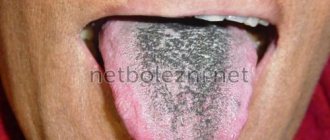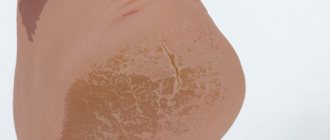Main symptoms
Sometimes the presence of cracks and grooves in the tongue is not accompanied by unnatural or painful sensations and can only be detected during examination by a dentist, ENT specialist or therapist. But this doesn't always happen. Patients often complain of the following related problems:
- pain;
- burning sensation;
- feeling that the tongue is loose;
- there is blood and ichor;
- elevated temperature;
- swelling and itching appeared;
- it becomes painful to chew;
- there is a problem with speech;
- increased salivation appeared;
- change in natural color;
- taste disturbance;
- the appearance of an unpleasant odor.
If cracks appear on the tongue, and the phenomenon is accompanied by one of the listed symptoms, then they speak of a progressive disease. This inflammatory process is referred to as glossitis; the prognosis for recovery from it is usually favorable. The appearance of erosions, furrows and ulcers indicates damage to the deep parts of the tongue. In this case, you should definitely contact a specialist.
Sometimes the tongue cracks and becomes covered with ulcers due to general damage to the ENT organs. Thus, tonsillitis or fungal pharyngitis can cause swelling and the appearance of white grooves. This condition is not isolated as an independent disease. Treatment in such cases begins with eliminating the underlying problem.
Glossalgia: what is it?
Glossalgia
If cracks are not treated in a timely manner, complications may follow, accompanied by pain and burning. In medicine, this disease is called glossalgia. Symptoms of this disease may include:
- Painful sensations occur when talking or eating. If an advanced form is observed, then the burning sensation will be present all the time.
- Sensitivity to taste disappears completely.
- The tongue begins to swell and may turn yellow
- My mouth begins to dry out.
Types of glossitis
In total, there are more than ten types of glossitis, three of which are accompanied by the appearance of cracks in the tongue. They have quite pronounced visible differences. To independently diagnose the type, you can compare the current state of the tongue with photos of classic manifestations of the disease.
Folded glossitis takes its name from the main external manifestation - the presence of folds. Sometimes, with this type of disease, a cracked tongue is present from birth. If it does not hurt, is not loose and there are no other unpleasant sensations, then the condition is considered normal. However, with deep cracks in the tongue, treatment is still necessary.
The problem of a folded tongue is often only of an aesthetic nature, although people with this feature are recommended to have constant monitoring by a dentist.
Desquamative glossitis is characterized by focal damage to the surface with almost imperceptible shallow cracks. The papillae desquamate and a whitish heterogeneous layer forms. The affected areas quickly recover, acquiring a natural color, and those adjacent to them become inflamed. The geometry of white areas (plaque) on the surface often changes. In advanced cases, due to the large number of cracks, a person feels the tongue is loose.
Diamond-shaped glossitis is characterized by the presence of a rhombic or oval-shaped area of red-blue color. It is located in the middle of the tongue, in the region of the posterior third. The tongue cracks in the center, so that the entire affected area seems to be divided into two parts. This type can be chronic, and during exacerbations, pain and burning begin.
Localization of cracks
The position of the cracks is not random. Localization is divided into three types, each of which is caused by specific problems. You can independently identify the type of localization by assessing the position of the cracks in the tongue: in the center, on the sides or at the tip.
The presence of cracks only at the tip of the tongue indicates the following causes of the problem:
- Thermal damage. Hot food first comes into contact with the tip of the tongue and causes major damage to it. Often the problem is contact with a hot metal spoon.
- Chemical damage. Occurs from contact with spicy, sour foods or corrosive substances.
- Physical impact. The tip can crack due to an incorrect bite or a cut on the sharp protruding parts of the incisors and canines.
Photo: cracks on the sides of the tongue
The formation of cracks in the tongue in the middle has a different reason, since it is almost impossible to injure this area without touching the periphery. This means that inflammation is an indicator of pathology or disease of internal organs. In addition, the formation of cracks in the center is possible when the middle area dries out, local circulation is impaired, or the immune system is weakened. There may be only one crack; upon examination, it appears as if the tongue has split into two parts.
The presence of cracks on the sides of the tongue can be caused by various reasons. If the inflammatory process is present on the side on one side, then this means physical damage from the sharp edges of small and large molars or dentures. If the tongue is cracked on both sides, it means that there are serious malfunctions in the functioning of the body , where glossitis acts only as an indicator of pathology.
What causes deep cracks to appear?
Damage to the tongue may differ in size and depth. Cracks with a depth of more than six millimeters are especially painful. In such cases, food debris collects in the depressions, causing decay and unpleasant painful sensations.
The reasons for the appearance of deep cracks are generally the same as the reasons for the appearance of small ones. The course of the disease is often accompanied by fever, poor health, and general weakness.
There are a number of diseases during which deep damage to the oral cavity occurs. One of these diseases is iron deficiency anemia, which is typical for the weaker half of humanity.
This fact can be explained by the fact that during childbirth the body weakens, and during breastfeeding a large amount of iron is lost. When the disease occurs, the entire oral cavity is affected, abscesses form on the tongue, as well as on the mucous membranes of the mouth.
Deep cracks appear due to a disease called “ geographical tongue.”
" More often the disease affects the female population, as well as children. The body becomes susceptible to developing the disease:
- during the period of growth of baby teeth in children;
- during puberty;
- during pregnancy.
The exact reasons for the development of the disease are unknown; scientists suggest that it could be both allergic reactions and disturbances in the functioning of the digestive system.
Causes of cracks
Folded glossitis can be detected immediately after the birth of the child. The cause is most often a hereditary predisposition, rather than a sign of any disease. Therefore, if a child has a cracked tongue, this is not yet a reason to start urgent treatment. Only if the grooves bleed or other problems are present should you seek medical help.
The causes of cracks in the tongue can be very different, but they all require diagnosis and elimination. The first type of prerequisites is of a dental nature; the problem arises due to the following phenomena:
- cuts to the organ by sharp edges of teeth or an incorrectly selected prosthesis;
- if diseases of the oral cavity or ENT organs are not treated for a long time;
- irritation from eating excessively hot, spicy, salty or sour foods;
- allergic reaction to medications or toothpaste taken.
The second type of reason, which explains why cracks appear on the tongue, can be described as indicator. It indicates the presence of a disease of the organs or circulatory system.
Another reason for the appearance of cracks in the tongue in adults may be a banal vitamin deficiency, leading to a decrease in immunity. It is usually observed in the following cases:
- the onset of the period from February to April, when there is no supply of vitamins from fresh vegetables and fruits for a long time;
- period of growing up with changes in hormonal levels;
- breastfeeding period.
Geographic language
The causes of cracks in both adults and children may lie in a disease called “geographical tongue.” In this case, the cracks are very deep, can reach 5-6 millimeters deep, which causes the patient severe discomfort and pain. All this is accompanied by general weakness, fever, the patient develops an unpleasant pungent odor from the mouth and a whitish coating. Most often, pregnant and lactating women, teenagers, and young children are susceptible to this type of disease. Reasons: unstable hormonal levels and weakened immunity. Here it is simply necessary to receive quality treatment in a timely manner. And in the photo you can see in detail why such a disease is called “geographical”. Doesn't it look like a map of the world?
Photo of geographic tongue
The causes of cracks are completely different, and in all cases, except those that indicate an anomaly acquired from birth, timely consultation with a doctor is required.
We probably won’t tell anyone the secret that treatment in such situations should be comprehensive, and it should not involve any amateur activity. It involves taking vitamins and medications as prescribed by a doctor, treating the mucous membrane with gels, lidocaine-based anesthetics, disinfection with furatsilin, physiotherapy, sanitation of the oral cavity, and replacement of dentures if necessary. Much attention should also be paid to correcting the diet and giving up bad habits, oral hygiene, rinsing with decoctions of medicinal herbs (chamomile, oak bark, sage).
Always remember: if cracks appear on your tongue, this is the first warning from your body that it needs qualified help.
Notice
: Undefined variable: post_id in
/home/c/ch75405/public_html/wp-content/themes/UltraSmile/single-item.php
on line
45 Notice
: Undefined variable: full in
/home/c/ch75405/public_html/wp-content /themes/UltraSmile/single-item.php
on line
46
Rate this article:
( 3 ratings, average: 5.00 out of 5)
language
- Sakharuk N.A. Oral candidiasis. Bulletin of Vitebsk State Medical University, 2007.
Medical assistance
If the tongue is cracked and hurts, is swollen on the sides, or there are other signs of the progressive development of the disease, then treatment must be started immediately . A protracted process can progress to a more complex stage, up to necrosis or oncology.
Constant inflammation causes intoxication of the body and is fraught with the entry of pus into the gastrointestinal tract.
Only a doctor can give a qualified answer to the question of why the tongue cracks. Due to the variety of possible causes of cracks in the tongue, the problem arises of which doctor to contact in order to establish the correct diagnosis and prescribe adequate treatment. First of all, you need to get examined by a dentist. This is necessary to identify prerequisites associated with problems in the oral cavity, or to exclude such a scenario.
If, as a result of a dental examination, the cause of cracks in the tongue was not identified, this means that the problem may be caused by diseases of the internal organs. Usually the patient knows or guesses from how he feels about its existence. Depending on the type of possible pathology, you need to contact a specialized specialist.
If there are no obvious signs of illness, you need to consult a therapist or pediatrician. You can first take a general blood test and do an ultrasound of the internal organs.
How is the disease diagnosed?
First of all, if grooves appear on the tongue or if it increases in size, you should contact your dentist. He will conduct a visual examination of your mouth. At this stage, it is important to identify the type of pathology and exclude (or confirm) diagnoses in which the same phenomena may be observed.
If a concomitant disease is suspected, the dentist refers the patient to the appropriate specialist - rheumatologist, venereologist, neurologist, endocrinologist, etc. – for additional examination.
Therapeutic treatment
First of all, to get rid of glossitis, it is necessary to diagnose and determine the nature of its occurrence, since it is impossible to cure cracks in the tongue without eliminating the provoking factor. The treatment method should be developed by a specialist in the underlying disease. Additionally, symptomatic treatment of the entire oral cavity is used, depending on the type of lesion. To do this, use the following methods:
- drug therapy aimed at improving local blood circulation in the tissues of the oral cavity;
- prescribing physiotherapeutic procedures such as electrophoresis;
- use of antiviral ointments;
- the use of drugs that stimulate epithelial restoration;
- taking antibiotics for fungal complications;
- administration of local anesthetics for severe pain.
Drug treatment of folded tongue
Since the causes of grooves are not fully understood, and changes in the mucous membrane are irreversible, treatment can only be symptomatic. For example, for fungal infections, antifungal drugs (sodium tetraborate in glycerin, aniline dyes, antifungal ointments based on imidazole) and/or anti-inflammatory drugs (Miramistin, chlorhexidine), as well as immunomodulators and vitamins are prescribed (for example, applications on the tongue with an oil solution of vitamins A and E).
If infectious lesions of the folds develop (food particles may remain in them, which serve as a breeding ground for bacteria), the doctor prescribes antibiotics, antiseptic rinses or mouth baths (for example, 25 drops of a 1% citral solution in half a glass of warm water).
Use of traditional medicine
At home, you can use well-known methods to help heal wounds in the mouth, eliminate pain, relieve swelling and other symptoms. However, before treating cracked tongue with folk remedies, you need to ensure their compatibility with the prescribed medications.
The most effective are the following recipes:
Herbal infusion of chamomile, celandine, sage and calendula. For adults, you can add St. John's wort. Take after meals in the form of baths or lotions. Promotes wound healing and relieves swelling.- Compresses from fermented milk products. Soften scars and scabs. The procedure should be done in the morning for 15 minutes.
- Sea buckthorn or olive oil. In the morning you need to drop a few drops on the mucous membrane and in the middle of the tongue, then do not drink or eat for 15 minutes. Softens dry formations on the tongue and mucous membranes.
- Honey. Has wound-healing and antimicrobial effects. A piece of the product can be placed in the middle of the tongue and dissolved. Gives a good effect if cracks bleed.
- Propolis tincture (for adults only). The strongest disinfectant: has antimicrobial, antibacterial and anti-inflammatory effects. Since alcohol tincture cannot be used in its pure form if there are open wounds, you need to dilute 1 teaspoon in 100 grams of warm tea. Drink after meals.
Lifestyle change
If a person’s tongue is covered with cracks, then it is necessary to exclude irritating factors when eating. This means that you need to remove hot, hot and spicy foods from your diet. It is necessary to limit the intake of store-bought and homemade marinades, sauces, and fried foods.
A balanced intake of vitamins A and B will help improve your general condition, which will have a beneficial effect on the speed of the process of getting rid of cracks. To provide the body with B vitamins and carotenes, you need to eat plant foods. Vitamin A and B12 are found in high concentrations in animal liver, dairy products and fish oil. In winter, if there is a shortage of vegetables and fruits that have not undergone deep heat treatment, it is necessary to take multivitamins.
Careful oral hygiene is required. It is better to clean teeth from plaque using a soft brush to avoid physical impact on the injured surface of the tongue, especially if it hurts.
Smoking is a significant problem because nicotine contributes to the development of stomatitis and gingivitis, diseases that often accompany glossitis . If your tongue is cracked, you should not drink strong alcohol, as it will cause burns to open wounds, which will take a long time to heal.
If a patient detects cracks in the tongue, doctors talk about a serious stage of glossitis, which must be treated urgently. In most cases, the treatment prognosis is favorable, and the technique depends on the causes of the disease, the neglect of the process and the presence of concomitant pathologies. The speed and effectiveness of therapeutic measures is directly related to how the patient complies with the recommendations of doctors.










